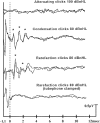Auditory neuropathy/dys-synchrony and its perceptual consequences
- PMID: 15920648
- PMCID: PMC4111505
- DOI: 10.1177/108471380500900102
Auditory neuropathy/dys-synchrony and its perceptual consequences
Abstract
Auditory neuropathy/dys-synchrony is a form of hearing impairment in which cochlear outer hair cell function is spared but neural transmission in the auditory pathway is disordered. This condition, or group of conditions with a common physiologic profile, accounts for approximately 7% of permanent childhood hearing loss and a significant (but as yet undetermined) proportion of adult impairment. This paper presents an overview of the mechanisms underlying auditory neuropathy/dys-synchrony-type hearing loss and the clinical profile for affected patients. In particular it examines the perceptual consequences of auditory neuropathy/dys-synchrony, which are quite different from those associated with sensorineural hearing loss, and considers currently available, and future management options.
Figures











Similar articles
-
Auditory neuropathy: endocochlear lesion or temporal processing impairment? Implications for diagnosis and management.Int J Pediatr Otorhinolaryngol. 2008 Aug;72(8):1135-50. doi: 10.1016/j.ijporl.2008.04.004. Epub 2008 May 27. Int J Pediatr Otorhinolaryngol. 2008. PMID: 18502518 Review.
-
[Otoacoustic emissions, auditory evoked potentials, pure tone thresholds and speech intelligibility in cases of auditory neuropathy].HNO. 2000 Jan;48(1):28-32. doi: 10.1007/s001060050005. HNO. 2000. PMID: 10663046 Review. German.
-
Auditory Neuropathy/Dys-Synchrony Disorder: Diagnosis and Management.Otolaryngol Clin North Am. 2015 Dec;48(6):1027-40. doi: 10.1016/j.otc.2015.06.006. Epub 2015 Aug 18. Otolaryngol Clin North Am. 2015. PMID: 26296649 Review.
-
OPA1-related auditory neuropathy: site of lesion and outcome of cochlear implantation.Brain. 2015 Mar;138(Pt 3):563-76. doi: 10.1093/brain/awu378. Epub 2015 Jan 5. Brain. 2015. PMID: 25564500 Free PMC article.
-
Auditory neuropathy/dys-synchrony: diagnosis and management.Ment Retard Dev Disabil Res Rev. 2003;9(4):225-31. doi: 10.1002/mrdd.10084. Ment Retard Dev Disabil Res Rev. 2003. PMID: 14648814
Cited by
-
The Potential Role of the cABR in Assessment and Management of Hearing Impairment.Int J Otolaryngol. 2013;2013:604729. doi: 10.1155/2013/604729. Epub 2013 Jan 30. Int J Otolaryngol. 2013. PMID: 23431313 Free PMC article.
-
Audiological changes over time in adolescents and young adults with auditory neuropathy spectrum disorder.Eur Arch Otorhinolaryngol. 2015 Jul;272(7):1801-7. doi: 10.1007/s00405-015-3505-0. Epub 2015 Jan 13. Eur Arch Otorhinolaryngol. 2015. PMID: 25577995
-
Neurophysiologic measures of auditory function in fish consumers: associations with long chain polyunsaturated fatty acids and methylmercury.Neurotoxicology. 2013 Sep;38:147-57. doi: 10.1016/j.neuro.2012.10.002. Epub 2012 Oct 12. Neurotoxicology. 2013. PMID: 23064205 Free PMC article. Review.
-
Auditory Neuropathy Spectrum Disorders: From Diagnosis to Treatment: Literature Review and Case Reports.J Clin Med. 2020 Apr 10;9(4):1074. doi: 10.3390/jcm9041074. J Clin Med. 2020. PMID: 32290039 Free PMC article. Review.
-
Bilirubin-Induced Audiologic Injury in Preterm Infants.Clin Perinatol. 2016 Jun;43(2):313-23. doi: 10.1016/j.clp.2016.01.006. Epub 2016 Feb 15. Clin Perinatol. 2016. PMID: 27235210 Free PMC article. Review.
References
-
- Abdala C, Sininger YS, Starr A. (2000). Distortion product otoacoustic emission suppression in subjects with auditory neuropathy. Ear Hear 21: 542–553 - PubMed
-
- Amatuzzi MG, Northrop C, Liberman C, et al. (2001). Selective inner hair cell loss in premature infants and cochlear pathological patterns from neonatal intensive care unit autopsies. Arch Otolaryngol Head Neck Surg 127: 629–636 - PubMed
-
- Bamford JM, Wilson IM, Atkinson D, Bench J. (1981). Pure tone audiograms from hearing-impaired children. Predicting speech-hearing from the audiogram. Brit J Audiol 15 (1): 3–10 - PubMed
-
- Berli CI. (1999). Auditory neuropathy: Using OAEs and ABRs from screening to management. Sem Hear 21: 307–315
-
- Berlin CI, Bordelon J, Hurley A, et al. (1997). Autoimmune inner ear disease: Basic science and audiological issues. In Berlin CI. (ed): Neurotransmission and Hearing Loss: Basic Science, Diagnosis and Management. San Diego: Singular Publishing Group, 137–146
Publication types
MeSH terms
LinkOut - more resources
Full Text Sources
Other Literature Sources
